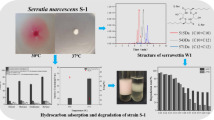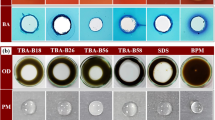Abstract
A hydrocarbon-degrading strain was isolated from a petroleum oil-contaminated site which was identified on the basis of 16S rDNA gene sequencing as a member of the genus Serratia. The isolate reduced surface tension of petroleum oil supplemented medium by 48.35% with respect to control after 7 days of treatment. Fluorescence microscopy revealed that its chemotaxis was towards hydrocarbon. The isolate degraded 87.54 and 85.48% of diesel and kerosene in liquid culture, respectively, after 28 day incubation at 37 ± 2 °C. The ex situ pilot scale bioremediation experiment in which artificially contaminated soil (10 and 20% v/w kerosene) was treated for 7 days showed a germination rate of Vigna radiate seeds of 52% and 72%, respectively. Interestingly, a germination rate of 31% was obtained with the heavily contaminated soil samples collected from the oil spillage site after 20 days of bioremediation treatment. The presence of υCH3 (asymmetric stretching), υC=C (stretch), and υC–C (stretch) in the crude biosurfactant produced by the isolate was revealed by FTIR analysis, and emulsification index (E24) was found 60 and 56.6%, respectively, against diesel and kerosene oil. The non-cytotoxicity nature of the biosurfactant also supports its potential application in field trial.









Similar content being viewed by others
References
Abouseoud M, Maachi R, Amrane A, Boudergua S, Nabi A (2008) Evaluation of different carbon and nitrogen sources in production of biosurfactant by Pseudomonas fluoresens. Desalination 223:143–151
Alegbeleye O, Opeolu B, Jackson V (2017) Bioremediation of polycyclic aromatic hydrocarbon (PAH) compounds: (acenaphthene and fluorene) in water using indigenous bacterial species isolated from the Diep and Plankenburg rivers, Western Cape, South Africa. Braz J Microbiol 48(2):314–325
Almansoory AF, Hasan HA, Idris M, Abdullah SRS, Anuar N, Tibin EMM (2016) Biosurfactant production by the hydrocarbon-degrading bacteria (HDB) Serratia marcescens: optimization using central composite design (CCD). J Ind Eng Chem. https://doi.org/10.1016/j.jiec.2016.11.043
Aparna GS, Smitha H (2012) Production and characterization of biosurfactant produced by a novel Pseudomonas sp. 2B. Colloids Surf B 95:23–29
Balseiro-Romero M, Gkorezis P, Kidd P, Van Hamme J, Weyens N, Monterroso C, Vangronsveld J (2017) Characterization and degradation potential of diesel-degrading bacterial strains for application in bioremediation. Int J Phytoremed 19(10):955–963
Batista SB, Mounteer AH, Amorim FR, Totola MR (2006) Isolation and characterization of biosurfactant/bioemulsifier-producing bacteria from petroleum contaminated sites. Bioresour Technol 97:868–875
Chaudhary D, Kim J (2017) Flavobacteriumolei sp. nov., a novel psychrotolerant bacterium isolated from oil-contaminated soil. Int J Syst Evolut Microbiol 67(7):2211–2218
Chen J, Zhang W, Li S, Zhang F, Ziu Y, Huang X (2018) Identifying critical factors of oil spill in the tanker shipping industry worldwide. J Clean Prod. https://doi.org/10.1016/j.jclepro.2017.12.238
Das K, Mukherjee AK (2007) Crude petroleum-oil biodegradation efficiency of Bacillus subtilis and Pseudomonas aeruginosa strains isolated from a petroleum-oil contaminated soil from North-East India. Bioresour Technol 98:1339–1345
Deepak R, Jayapradha R (2015) Lipopeptide biosurfactant from Bacillus thuringiensis pak2310: a potential antagonist against Fusarium oxysporum. J Med Mycol 25:15–24
Desai JD, Banat IM (1997) Microbial production of surfactants and their commercial potential. Microbiol Mol Biol Rev 61:47–64
El-Sheshtawy H, Aiad I, Osman M, Abo-ELnasr A, Kobisy A (2015) Production of biosurfactant from Bacillus licheniformis for microbial enhanced oil recovery and inhibition the growth of sulfate reducing bacteria. Egypt J Pet 24(2):155–162
Ferhat S, Mnif S, Badis A, Eddouaouda K, Alouaoui R, Boucherit A (2011) Screening and preliminary characterization of biosurfactants produced by Ochrobactrum sp. 1C and Brevibacterium sp. 7G isolated from hydrocarbon-contaminated soils. Int Biodeterior Biodegrad 65:1182–1188
Ghoreishi G, Alemzadeh A, Mojarrad M, Djavaheri M (2017) Bioremediation capability and characterization of bacteria isolated from petroleum contaminated soils in Iran. Sustain Environ Res 27(4):195–202
Gong Y, Zhao X, Cai Z, O’Reilly SE, Hao X, Zhao D (2014) A review of oil, dispersed oil and sediment interactions in the aquatic environment: influence on the fate, transport and remediation of oil spills. Mar Pollut Bull 79:16–33
Gordon G, Stavi I, Shavit U, Rosenzweig R (2018) Oil spill effects on soil hydrophobicity and related properties in a hyper-arid region. Geoderma 312:114–120
Graj W, Lisiecki P, Szulc A, Chrzanowski Ł, Wojtera-Kwiczor J (2013) Bioaugmentation with petroleum-degrading consortia has a selective growth-promoting impact on crop plants germinated in diesel oil-contaminated soil. Water Air Soil Pollut 224:1676
Guermouche MA, Bensalah F, Gury J, Duran R (2015) Isolation and characterization of different bacterial strains for bioremediation of n-alkanes and polycyclic aromatic hydrocarbons. Environ Sci Pollut Res 22(20):15332–16346
Hemmer MJ, Barron MG, Greene RM (2011) Comparative toxicity of eight oil dispersants, Louisiana sweet crude oil (LSC), and chemically dispersed LSC to two aquatic test species. Environ Toxicol Chem 30(10):2244–2252
http://www.itopf.com/knowledge-resources/data-statistics/statistics/. Accessed: 28 June 2018
Jemil N, Hmidet N, Ben Ayed H, Nasri M (2018) Physicochemical characterization of Enterobacter cloacae C3 lipopeptides and their applications in enhancing diesel oil biodegradation. Process Saf Environ Prot 117:399–407
King G, Kostka J, Hazen T, Sobecky P (2015) Microbial responses to the deepwater horizon oil spill: from coastal wetlands to the deep sea. Annu Rev Mar Sci 7(1):377–401
Lacal J, Muñoz-Martínez F, Reyes-Darías J, Duque E, Matilla M, Segura A, José J, Calvo O, Jímenez-Sánchez C, Krell T, Ramos JL (2011) Bacterial chemotaxis towards aromatic hydrocarbons in Pseudomonas. Environ Microbiol 13(7):1733–1744
Lim M, Lau E, Poh P (2016) A comprehensive guide of remediation technologies for oil contaminated soil-present works and future directions. Mar Pollut Bull 109(1):14–45
Liu J, Chen Y, Xu R, Jia Y (2013) Screening and evaluation of biosurfactant-producing strains isolated from oilfield wastewater. Indian J Microbiol 53(2):168–174
Mahanty B, Pakshirajan K, Dasu VV (2006) Production and properties of a biosurfactant applied to polycyclic aromatic hydrocarbon solubilisation. Appl Biochem Biotechnol 134:129–141
Maila MP, Cloete TE (2002) Germination of Lepidium sativum as a method to evaluate polycyclic aromatic hydrocarbons (PAHs) removal from contaminated soil. Int Biodeterior Biodegrad 50:107–113
Mandri T, Lin J (2007) Isolation and characterization of engine oil degrading indigenous microrganisms in Kwazulu-Natal, South Africa. Afr J Biotechnol 6:23–27
Marchal O, Stocker T, Joos F (1998) Impact of oceanic reorganizations on the ocean carbon cycle and atmospheric carbon dioxide content. Paleoceanography 13(3):225–244
Méndez V, Fuentes S, Morgante V, Hernández M, González M, Moore E, Seeger M (2017) Novel hydrocarbonoclastic metal-tolerant Acinetobacter and Pseudomonas strains from Aconcagua river oil-polluted soil. J Soil Sci Plant Nutr 17(4):1074–1087
Meng L, Li H, Bao M, Sun P (2017) Metabolic pathway for a new strain Pseudomonas synxantha LSH-7′: from chemotaxis to uptake of n-hexadecane. Sci Rep 7:39068
Mohanan S, Maruthamuthu S, Muthukumar N, Rajasekar A, Palaniswamy N (2007) Biodegradation of palmarosa oil (green oil) by Serratia marcescens. Int J Environ Sci Technol 4(2):279–283
Morelli IS, Del Panno MT, De Antoni DL, Painceira MT (2005) Laboratory study on the bioremediation of petrochemical sludge-contaminated soil. Int Biodeterior Biodegrad 55:271–278
Mukherjee AK, Bordoloi NK (2011) Bioremediation and reclamation of soil contaminated with petroleum oil hydrocarbons by exogenously seeded bacterial consortium: a pilot-scale study. Environ Sci Pollut Res 18:471–478
Ozyurek B, Bilkay SI (2017) Biodegradation of petroleum by Klebsiella pneumoniae isolated from drilling fluid. Int J Environ Sci Technol 1:1. https://doi.org/10.1007/s13762-017-1581-y
Padaki M, Murali RS, Abdullaha MS, Misdana N, Moslehyani A, Kassima MA, Hilal N, Ismail AF (2015) Membrane technology enhancement in oil–water separation. A review. Desalination 357:197–207
Patowary R, Patowary K, Kalita MC, Deka S (2018) Application of biosurfactant for enhancement of bioremediation process of crude oil contaminated soil. Int Biodeterior Biodegrad 129:50–60
Pi Y, Bao M, Li Y, Li G, Lu J, Sun P (2015) Characterization of crude oil degrading microbial cultures isolated in Qingdao China. RSC Adv 5(118):97665–97674
Pimda W, Bunnag S (2017) Impact of inorganic nutrients and heavy metals present as co-contaminants on biodegradation of petroleum hydrocarbons by Phormidium ambiguum strain TISTR 8296. Water Air Soil Pollut 228:58
Rajasekar A (2017) Biodegradation of petroleum hydrocarbon and its influence on corrosion with special reference to petroleum industry. In: Biodegradation and bioconversion of hydrocarbons, 1st edn. Springer, Singapore, pp 307–336
Rajasekar A, Balasubramanian R, Kuma VMJ (2011) Role of hydrocarbon degrading bacteria Serratia marcescens ACE2 and Bacillus cereus ACE4 on corrosion of carbon steel API 5LX. Ind Eng Chem Res 50(17):10041–10046
Ramadass K, Megharaj M, Venkateswarlu K, Naidu R (2018) Bioavailability of weathered hydrocarbons in engine oil-contaminated soil: impact of bioaugmentation mediated by Pseudomonas spp. on bioremediation. Sci Total Environ 636:968–974
Ramasamy S, Mathiyalagan P, Chandran P (2014) Characterization and optimization of EPS-producing and diesel oil-degrading Ochrobactrum anthropi MP3 isolated from refinery wastewater. Pet Sci 11(3):439–445
Ripley MB, Harrison AB, Betts WB, Dart RK (2002) Mechanisms for enhanced biodegradation of petroleum hydrocarbons by a microbe-colonized gas–liquid foam. J Appl Microbiol 92:22–31
Rosenberg E, Ron EZ (2002) Biosurfactants and oil bioremediation. Curr Opin Biotechnol 13:249–252
Sangeetha J, Thangadurai D (2014) Effect of biologically treated petroleum sludge on seed germination and seedling growth of Vigna unguiculata (L.). Walp (Fabaceae). Braz Arch Biol Technol 57(3):427–433
Silva R, Almeida D, Rufino R, Luna J, Santos V, Sarubbo L (2014) Applications of biosurfactants in the petroleum industry and the remediation of oil spills. Int J Mol Sci 15(7):12523–12542
Sousa M, Melo VMM, Rodrigues S, Sant’ana HB, Gonçalves LR (2012) Screening of biosurfactant-producing Bacillus strains using glycerol from the biodiesel synthesis as main carbon source. Bioprocess Biosyst Eng 35:897–906
Tugrul T, Cansunar E (2005) Detecting surfactant-producing microorganisms by the drop-collapse test. World J Microbiol Biotechnol 21(6–7):851–853
Viramontes-Ramos S, Portillo-Ruiz M, Ballinas-Casarrubias M, Torres-Muñoz J, Rivera-Chavira B, Nevárez-Moorillón G (2010) Selection of biosurfactan/bioemulsifier-producing bacteria from hydrocarbon-contaminated soil. Braz J Microbiol 41(3):668–675
Wu T, Xie W, Yi Y, Li X, Yang H, Wang J (2012) Surface activity of salt-tolerant Serratia spp. and crude oil biodegradation in saline soil. Plant Soil Environ 58(9):412–416
Yenn R, Borah M, Boruah HP, Roy AS, Baruah R, Saikia N, Sahu OP, Tamuli AK (2014) Phytobioremediation of abandoned crude oil contaminated drill sites of Assam with the aid of a hydrocarbon-degrading bacterial formulation. Int J Phytoremed 16(7–12):909–925
Acknowledgements
Authors acknowledge DST-Govt. of India and Ministry of Higher Education & Scientific Research, Govt. of Tunisia (Grant No. DST/INT/TUNISIA/P-02/2017) for funding. Authors also acknowledge DBT-HRD, Govt. of India (Grant No. BT/04/NE/2009) and DBT-BIF facility (BT/BI/13/035/2017) for providing necessary infrastructure facility to Centre for Biotechnology and Bioinformatics, Dibrugarh University; DeLCON DBT-Electronic Library Consortium facility to Dibrugarh University; Dept. of Chemistry for providing FTIR facility; Departmental Animal Cell Culture Laboratory, Centre for Biotechnology and Bioinformatics, DU; Azyme Biosciences Pvt. Ltd., Bangalore for GLC analysis; and Pentavalent Biosciences Pvt. Ltd., Bangalore for providing sequencing services for bacterial identification.
Author information
Authors and Affiliations
Corresponding author
Ethics declarations
Conflict of interest
The authors declare that they have no conflict of interest.
Rights and permissions
About this article
Cite this article
Borah, D., Agarwal, K., Khataniar, A. et al. A newly isolated strain of Serratia sp. from an oil spillage site of Assam shows excellent bioremediation potential. 3 Biotech 9, 283 (2019). https://doi.org/10.1007/s13205-019-1820-7
Received:
Accepted:
Published:
DOI: https://doi.org/10.1007/s13205-019-1820-7




